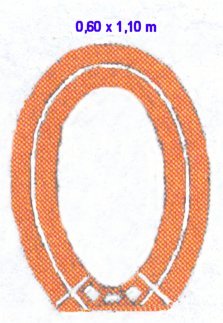
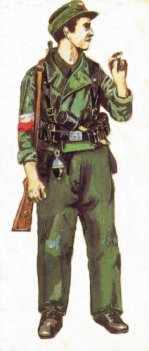
Adult insurgent at the lowest canal
Warsaw sewers
In the XIX century, Warsaw was, to all intents and purposes, bereft of an efficient water supply and sewage system. The Russian general, Sokrates Starynkiewicz, who was the president of Warsaw from 1875 to 1892, took it upon himself to resolve this problem. Thanks to his obstinacy and exceptional honesty at the time of the greatest suppression from the tsars after the January Uprising, he transformed Warsaw from a grimy, squalid provincial city into a modern one.
During his term of office, street lighting, telephones and horse-drawn trams were introduced, trees were planted and new streets built (up to 1889 of concrete). Market places were tidied up (the Mirowska Hall and the one on Koszykowa street were erected at this time, too) and the new cemetery in Brodno appeared.
Without a doubt, president Starynkiewicz's greatest accomplishment was the creation of a modern water supply and sewage system. The project was entrusted to the English engineer, William Lindley, who had planned and built similar enterprises in more than 30 European cities to include Hamburg, St. Petersburg and Basle.
A contract with W. Lindley was signed in 1881 and work began in 1883, continuing for some years. As early as 1886, water began to flow from the filter station on Koszykowa St. and the first water collector was completed. Up until 1900, the investment had cost 17 million rubles as compared to Warsaw's annual budget of 2.5 million.
The canalisation system was designed taking into account the natural decline running parallel to the river Vistula, from south to north. The main canals were built in this direction receiving private and industrial waste as well as precipitation. Entry into the Vistula occurred at a number of planned locations.
The Warsaw canals had the shape of an upturned egg. They were made of cement-based bricks and siliceous pipes. They were divided into 11 groups, depending on the section: the smallest measured 60x90 cm, the largest 160x210 cm. After 1889, the canal height was increased by 20-30 cm. The largest were 160x240 cm. Every 80 metres, street inlets were installed admitting rain water.
In 1944, at the outbreak of the Uprising, which was to last 3-4 days, no thought was given to the possibility of using the sewers for communication and liaison purposes. With the prolongation of fighting and the emergence of a number of isolated resistance locations, a problem arose, namely, communication. The sewer network was utilised for liaison purposes, transportation of weapons and ammunition and later for the evacuation of large numbers of Uprising members from fallen districts.
With the participation of sewer staff, attempts were made to connect the Powisle with the Stare Miasto and the Stare Miasto with the Srodmiescie. On the recommendation of the AK Headquarters' Liaison Association, the monograph of the water supply and sewage system containing Warsaw's canalisation network plan and particulars regarding their diameter were extricated from the Department of Water Supply and Canalisation on Lipowa Str., while it was under fire. Based on this, the possibility of using the canals as communication corridors and liaison purposes was analysed.
Special sewer patrols were created and mainly consisted of women, but young boys, usually scouts, joined later. The most important thing was that the patrol member be of slight build and not tall. These requirements were imposed on by the sewer measurements which, at the most, were 110 cm. high. One must not forget the sewers were not dry. Water or sewage flowed through them, often reaching the knees and even above the waist. Considering also that movement was in complete darkness, an exceptional predisposition was required to fulfill this task.


Adult insurgent at the lowest canal
Special Liaison Platoons were formed to service the sewers and were under the AK Headquarters.
A number of main routes were marked out:
Stare Miasto - Zoliborz: length approx. 3,060 m., manhole in Zoliborz on corner Sloneczna (today J. Popieluszko) and Krasinski St., manhole in Stare Miasto on Dluga Str. By Krasinskis Sq.
Zoliborz - Srodmiescie: length approx. 4,830 m., manhole in Zoliborz on corner Sloneczna (today J. Popieluszko) and Krasinski Str. manhole in Srodmiescie on Zgoda St.
Stare Miasto - Srodmiescie: length approx. 1,600 m., manhole in Stare Miasto on Dluga Str. by Krasinskis Sq., manhole in Srodmiescie on Nowy Swiat by Warecka Str.
Stare Miasto - Srodmiescie: length approx. 1,370 m., manhole in Stare Miasto on Danilowiczowska Str. (today Nowy Przejazd), manhole in Srodmiescie on Mazowiecka Str. by Swietokrzyska.
|
Stare Miasto - Bankowy Sq.: lenghth approx. 1,430 m., manhole in Stare Miasto on Dluga Str. by Krasinskis Sq., manhole on Bankowy Sq. near building by Senatorska Str. 40
Srodmiescie South - Mokotow: length approx. 2,080 m., manhole in Srodmiescie on Ujazdowskie Alley 43 by Wilcza Str., manhole in Mokotow on Wiktorska Str. by Pulawska Str.
Srodmiescie South - Mokotow through Lazienki: length approx. 3,700 m., manhole in Srodmiescie on Ujazdowskie Alley 43 by Wilcza Str., manhole in Mokotow on Wiktorska Str. by Pulawska Str.
Czerniakow - Mokotow: length approx. 3,790 m, manhole in Czerniakow on Zagorna Str., manhole in Mokotow on Wiktorska Str. by Pulawska Str.
Ochota - Srodmiescie length approx. 1,000 m. A very low, narrow canal, tunnel from Reduta Wawelska to manhole on Wawelska St. 60, manhole in Srodmiescie on Prokuratorska Str. in Kolonia Staszica.
During the first phase of the Uprising, the sewers were used to transport weapons, ammunition and first-aid materials and liaison purposes. They were also instrumental in the distribution of post.
A water-resistant telephone cable, installed in the sewer, connected the Srodmiescie to the Starowka. The connection lasted from 15 August till the moment when the insurgent groups left the Stare Miasto.
At first, the Germans did not realize the importance of the sewers for the Warsaw Uprising. General von dem Bach ignored the incoming reports about the use of the sewers by the insurgents. It was only when those defending the Starowka disappeared that the German command realised that the insurgents could, at any moment, appear from behind. The sewer telephone network was also discovered.
From that moment on, the Germans undertook all measures to incapacitate the use of the sewers by the Poles. They isolated parts of the sewer system, manholes were guarded and canal wells were tapped. When they heard people in the sewers, they threw down grenades and tins filled with tear and poisonous gas. They machine-gunned from above. They built dams using metal girders, logs and sand bags with the intention of raising the water level and so impeding movement.
Later, General von dem Bach admitted to also sending spies to the various areas of the Uprising. These were mainly Volksdeutsch or Ukrainians. After completing their task, which consisted of passing on the obtained information, they usually left the city with the civilian population.
In spite of the impediments imposed on by the Germans, work in the sewers continued up to the end of the Uprising. Slender girls and boys (often very young) carried situational reports, medication, first-aid materials and ammunition. One load of ammunition, carried on the chest in a special bag, weighed max. 3-5 kg. The exertion was, therefore, tremendous and more could not be carried because of the prevailing conditions.
Below an excerpt from an account given by a female member of the sewer patrol from Srodmiescie to Stare Miasto:
"We descend the cement well using the metal brackets. The group is made up of several people, including the leader. At the bottom we receive wooden rods approx. 50cm long. We bend down low, using both hands we grasp the rod tightly from above and attach it between the sewer walls. In this position we draw up one leg, move the rod forward and draw the second leg up. The back rubs against the vault. The stone ceiling crushes you to the ground. After a while you think you're going mad.
We throw the rods away and continue on our knees. Below flows a nasty, stinking substance. On the sewer bottom there is sand and, in places, sharp-edged gravel. The knees begin to hurt badly, as if on fire. We regret having thrown away the rods. We crawl along. The flowing water becomes cleaner and, what's more important, the sewer is higher. At last, we can stretch. We've finally reached the high well with metal hooks. We've managed to bring the load on our chest, without getting it wet.
We climb painstakingly to the manhole by Krasinskis Sq. All around the red glow of fires and rising clouds of smoke. We're in Starowka."
Whilst moving in the sewers, the groups marked the way with signs and arrows to avoid taking the wrong direction or ending up in a dead-end (sometimes this did happen).
The sewers were not only used for liaison and supply but also for evacuation purposes. During evacuation, large groups of people moved in the sewers, were often fully equipped and, more often than not, this was their first encounter with such dramatic circumstances. This meant additional impediments and danger.
The unavoidable noise factor in such conditions increased the danger of being discovered by the Germans and their inevitable reaction. Moreover, they were often unable to cope with the extreme conditions and broke down. Many lost their bearings and some even committed suicide.
The first evacuation took place in the Ochota sewer. On 7 August 1944, the insurgent group defending "Reduta Wawelska" (built-up area between Wawelska, Pluga, Mianowski, and Uniwersytet Str.) having been surrounded and attacked by the greater enemy numbers decided to withdraw from the besieged redoubt. The only evacuation exit was the sewer, which was unfortunately, under enemy fire.
It was decided to dig a passage from the cellars on the Wawelska Str. side to the manhole. Work was completed on 10 August, in the evening. On 11 August, after some unsuccessful attempts at finding the way, the group of defenders, 83 in all, completed a kilometer, passing through an exceptionally low part of the sewer system, measuring 110x60 cm. They exited at the manhole on Prokuratorska Str. in the Staszica Colony. This was the first time a uniform armed detachment of the Uprising had passed through the sewers. It took them 6 hours to get through the dark and low sewer.
|
The purpose of the attacks on the Gdansk train station, on 20 and 21 August 1944, was to connect Stare Miasto to the Srodmiescie but they were unsuccessful and so it was decided to evacuate the wounded, the staff of the second fighting group, part of the medical personnel, the municipal authorities and civilians using the sewers from Starowka to Srodmiescie and Zoliborz. These plans were only partially carried out. The height of the sewers disallowed movement in the direction of Srodmiescie and as a result drainage work on the sewers was begun.
During the night of 25 to 26 August, a group of more than 40 people moved from Starowka to Srodmiescie, the AK headquarters with general Bor Komorowski and the civilian authorities with Kazimierz Puzak, chairman of the People's National Unity.
In view of the German ring tightening around the Stare Miasto, the Uprising commanders attempted to get through to the Srodmiescie. The attack, with the participation of Srodmiescie groups, was to go in the direction of Krolewska Str. and Hale Mirowskie. It was to be supported by a surprise assault on Bank Sq.. Soldiers from the battalions, "Czata 49" and "Gustaw" were used, in all 150 people. Their commander was Capt. "Motyl" Zbigniew Scibor-Rylski from "Czata 49."
On 30 August 1944, at dusk, the group entered the sewer using the manhole on Krasinskis Sq. and headed in the direction of Bankowy Sq., which they reached around 1 a.m. having covered 1.5 km. of sewer measuring a max. of 170 cm. and a min. of 90 cm. The first group of soldiers surfaced by the fountain there and hid in the bushes near the statue of St. Jan Nepomucen.
|
Nearby, it turned out that many Germans were sleeping, propped up against the walls of the neighbouring houses but the openness of the area did not allow the soldiers to take up suitable shooting positions. One of the German soldiers noticed them, raised the alarm and the awakened Germans began shooting.
Overcome by the shooting in this open expanse, the insurgents suffered losses and after battling for 45 min. they were forced to retreat and return. After returning to the sewer, some soldiers returned to the Stare Miasto, the remainder reached the manhole on Nowy Swiat by Warecka Str. The attack on the surface also failed. The attempt to break through ended in failure.
The commanders of Stare Miasto, therefore, decided to carry out an evacuation lasting a few days, beginning 1 September. The first to be evacuated were to be the slightly wounded and unarmed soldiers, followed by the retreat of detachments with arms, ammunition and equipment. Every two hours, the section leaders were to send off groups of 50 with a line. It was planned to complete the evacuation of 1.500 soldiers by 2 September at 9 a.m.
|
During the night of 31 August to 1 September, the sappers completed a covered access from the cellars of the Court of Appeal to the main manhole on Krasinskis Sq. and an access to the manhole, securing it with walls made of pavement slabs. At the same time, the Germans were forcibly ramming the Stare Miasto and firing and bombarding continued. The evacuation of the wounded and unarmed soldiers continued throughout the entire day of 1 September and the losses were great. The evening of 1 September saw the battle move to the area adjacent to Krasinskis Sq.
An order was given for the detachments of the line to be evacuated in the following order:
- Concentration "Rog",
- Hospitals,
- Concentration "Sosna",
- Group staff and detachment command,
- Concentration "Radosław",
- Back guards.
The soldiers were divided into groups of 50, each with a leader. Group by group, the insurgents headed for Nowy Swiat. The conditions were ghastly. The soldiers moved slowly, step by step, wading in faeces reaching their ankles, knees and, in some low parts, almost their faces.
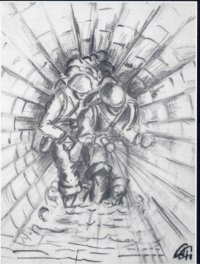
March through the sewer (drawing Wieslaw Chrzanowski)
Abandoned weapons and even the bodies of those who had not withstood the tribulations of this tramp could be felt beneath the feet. After completing the route in about 4 hours they exited at the second manhole on the Nowy Swiat by Warecka Str. and encountered a totally different world. The sun was shining, well-dressed ladies were walking about, the windows had panes.
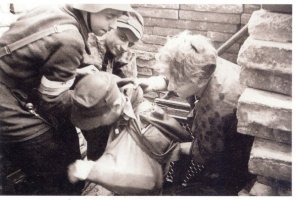
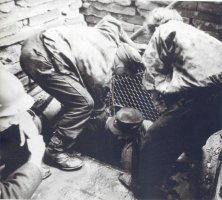
Exit from Starowka on Warecka Str.
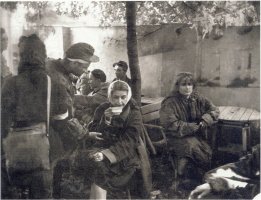
Respite after exiting the sewers
The bulk of the evacuation work rested with the nurses and liaison officers, who carried the wounded through the sewers, escorted to the Srodmiescie and returned for the next ones in order to evacuate as many and as quickly as possible. Remarkable services were rendered by experienced canal guides, amongst whom was the group of Jews freed from the camp in Gesiowka by the "Zoska" soldiers. They continued fighting with "Radoslaw" group in Czerniakow where some met a soldier's death.
On the morning of 2 September, guarding detachments, consisting of captives and wounded, descended into the canals. As civilians attempted to enter, there was an air raid resulting in the collapse of the Court of Appeal. The rubble buried the manhole and the people scrambling to enter it.
Eventually, around 3,000 slightly wounded and members of administrative groups and a fighting group of around 1,500 soldiers reached the Srodmiescie from the Stare Miasto. Around 800 insurgents, together with detachments of the AL (AL - Armia Ludowa - People's Army, communist underground organisation during WWII), reached Zoliborz.
|
Around 200 insurgents remained in the Stare Miasto, most of them intermingling with the civilian population. 2,500 seriously wounded remained with some of the nurses in field hospitals and more than 40,000 civilians (5,000 of them seriously wounded).
After the German forces encroached on the Stare Miasto, murder and rape occurred on a vast scale. The majority of the badly wounded were murdered and only a few were removed elsewhere. Some of them survived thanks to the help given by the wounded German soldiers, recent Uprising captives, also in the same hospital. Those who were suspected of belonging to the AK and the infirm were shot on the spot. The remaining were taken to the camp in Pruszkow.
Immediately after the fall of the Stare Miasto, attempts were made to build up contact between the Srodmiescie and Zoliborz. Sewer patrols left from both in an attempt to find a route, one of which ran beneath the ghetto ruins. One route was found impassable due to a dam of human bodies. Barriers, erected by the Germans, were also found and attempts were made to blow them up or disband them.
After 10 September, a route from Zoliborz to the Srodmiescie was successfully set out. It connected the manholes on Stoleczna Str. (today Popieluszko) in Zoliborz and on Zgoda Str. in the Srodmiescie. The entire length of the route was 4,840 m.
|
The route was served by members, mainly women, of the Special Liasion Group for the Headquarters and Warsaw District AK. The sewers could be entered by them and those holding special permits. Guard duty was implemented in the sewers and it was forbidden to carry private correspondence or spread information on the duties being carried out.
The sewer communication between the Zoliborz and the Srodmiescie lasted till 29 September 1944, in other words, up to the capitulation of Zoliborz. Attempts were made to establish a telephone link by way of a cable laid in the sewer. The work, which was undertaken in extremely difficult circumstances, was completed in the evening of 28 September, one day before Zoliborz capitulated. The tremendous effort exerted by the liaison people had, practically speaking, no effect.
During the entire duration of the Uprising and up to the capitulation on 27 September 1944, Mokotow was isolated and cut-off from the Srodmiescie. From the first days of August, both sides endeavoured to make contact. On 7 August, after a number of unsuccessful attempts, two Gen. "Monter" female liaison officers proceeded from the manhole in Ujazdowskie Alley on Trzech Krzyzy Sq. They had previously acquainted themselves with the sewer network schema and now followed the collector running beneath the German district heading for Unia Lubelska Sq. After some hours they reached the manhole in Mokotow. On surfacing, they decided they were in the vicinity of Szustra Str. and not knowing the watchword used in Mokotow they proved their identity by using the command's cryptonym. They were taken to the command of the regiment "Baszta" where they reported that they had come from the Srodmiescie and had brought orders from Gen. "Monter".
|
And so the connection between the two fighting districts became a fact. General outlines concerning the establishment and upkeep of the contact sewer were made. The route was a very difficult one. Along a 60 m stretch, the sewer was only 70 cm high, which meant one had to crawl. Efforts were made to find an easier route and bore fruition.
The new route from Pulawska Str. by Dworkowa Str. followed the storm-water drain and ended at the manhole at the intersection of Ujazdowskie Alley and Wilcza Str. Difficult sections were equipped with lines attached to the walls - protection against slipping. This was the only communication line not discovered by the Germans during the entire duration of the Warsaw Uprising.
|
Communication in the sewers to the south was highly conspiratorial. It could only be used by people with special watchwords. The manholes were guarded by the military police. Apart from the liaison members, officers were sent to Mokotow on special missions. In the middle of September the "Zawiszaks" from the Scouts' Field Post obtained permission to use the sewer. They were instrumental in the distribution of letters addressed to the inhabitants of both districts.
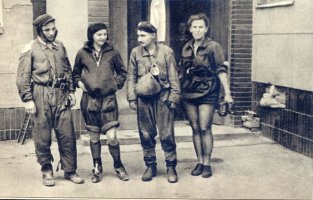
The first group of liaison officers from Srodmiescie to Mokotow
In the second half of September 1944, the Uprising fighters waged fierce battles against the advancing attacks of the predominant enemy numbers in Czerniakow. Not even the surprise assault over the Vistula by Gen. Berling two battalions of the 8 Infantry Regiment could do much to change the situation. What remained of the "Radoslaw" and "Kryska" concentrations was pushed into the area around Wilanowska and Zagorna Str.
On the morning of 15 September, Lt. Col. "Radoslaw" sent a message, via the sewers to Mokotow, explaining the situation. On 15 September in the afternoon, Lt. Col. "Slawbor," Jan Szczurek-Cergowski, commander of the Srodmiescie sub-district, sent a liaison officer to contact "Radoslaw." She reached Czerniakow 3 hours later. That same day she returned with a message from "Radoslaw" for "Slawbor."
Early on 16 September, "Slawobor" sent the fighters in Czerniakow his complete ammunition reserves i.e. 500 rounds for kb (infantry rifle), 500 rounds for machine guns, and 2 machine guns produced in the Soviet Union with 200 rounds. Unfortunately the transport did not reach the fighting and returned to the Srodmiescie.
Late in the evening of 19 September, Lt. Col. "Radoslaw" made the decision to evacuate the remainder of his concentration (wounded and those without ammunition) through the sewers to Mokotow. The other armed insurgents, numbering around 160, under the leadership of Cpt. "Jerzy," Ryszard Bialous, continued defending with the remaining Berling men under the command of Maj. Latyszonek. The retreat occurred at midnight 19 to 20 September 1944. Approximately 200 people, including 50% wounded, reached the Mokotow manhole on Dworkowa Str. Apart from members of "Radoslaw", there were some from "Kryska".
|
Czerniakow finally fell on 23 September. Some of the insurgents who did not fall in battle were murdered by the SS, among them the chaplain of "Kryska," Jozef Stanek "Rudy" who was hung on the building. Only a few managed to reach the opposite bank of the Vistula and some, under the leadership of Cpt. "Jerzy," reached the Srodmiescie after breaking through the Ksiazeca Str. A small group of insurgents and Berling men were treated as prisoners of war. Some others mingled with the crowd and ended up in Pruszkow.
The storming of Mokotow took place on 24 September 1944. After 2 days of fierce fighting, which saw the insurgents pushed to an area limiting their defence and many losses, the leadership decided to return to Mokotow by way of the sewers. The first to leave were to be those most likely to suffer repression from the enemy: headquarters, officials of the II division (counter-espionage), PAL soldiers, propaganda divisions, court and prosecution, military police executing sentences on members of the SS, SA, Volksdeutsch and the Kedyw under Lt. Col. "Radoslaw." Those slightly wounded but still able to walk unaided were also to leave. The remaining divisions were to act as guards and were put under the leadership of Maj. "Zryw", Kazimierz Sternal.
The evacuation began on 26 September, in the early hours of the morning. The column was to descend the manhole on Wiktorska Str. and the destination was to be the manhole on Wilcza Str. Most of those leaving Mokotow had never been in a sewer before. As soon as the first group entered the sewer, a German plane neared and bombed Pulawska Str. near the manhole. They were buried under rubble. Panic broke out. The column turned about and ran to the manhole, which had been destroyed by the bomb. The march had, therefore, to be continued. After an 11 hour trek, the soldiers finally surfaced at the Jerozolimskie Alley, without losses.
As the manhole on Wiktorska Str. and part of the sewer route had been destroyed, the manhole on Szustra Str. was made available. A small narrow canal led from it to the collector, just as under Wiktorska Str.
At 16.00, a 2 hour cease-fire took place. Civilians began departing Mokotow. The commander, Lt. Col. "Karol," Jozef W. Rokicki informed Gen. "Monter" by radio that he was preparing to evacuate divisions to the Srodmiescie that evening. "Monter" said he did not agree and instead demanded a defence. In the afternoon, the next German attack took place. At 20.00, Lt. Col. "Karol" decided to begin with the evacuation.
A crowd had gathered at the manhole on Szustra Str. and "Radoslaw" soldiers and Maj. "Zryw" were attempting to bring order to it. In the meantime, after several hours, the first evacuees had reached the Srodmiescie and were exiting the manhole on Wilcza Str. The confusion was increasing. Even people with falsified papers were entering the manhole. Uncontrolled manholes were being entered, including the one on the corner of Szustra and Balucki Str. as well as on Belgijska Str.
The actual evacuation began at 21.00. The people entered in turn but often not in the planned order - wounded, civil authorities, health services, refugees, wounded from B-3 division of "Baszta" and the remainder of the "Garda" battalion. At 23.15, Lt. Col. "Karol" with his attendants entered the canal and at midnight the guards were to retreat.
The main group moved slowly, at first. It then stopped. As it was really only possible for one person to move in the sewer the reason for the delay was uncertain. A guide was sent off to ascertain the situation and it turned out that, on a stretch of around half a kilometer, the soldiers had sat down in the stinking water and did not want to move. They were tired and half-asleep.
Lt. Col. "Karol" accompanied by a sergeant managed to get through, although with great difficulty. It turned out that the soldiers of the 1 Regiment Light Cavalry were facing a stretch of the sewer, which was filled with a stinking slush, almost shoulder deep. Further on the next hurdle - metal tracks wrapped in barbed wire thrown in to impede progress. Liaison officers sent by "Karol" unbent the wire but it was only possible for one person to squeeze through the aperture. A few metres further down the Germans had set up another such trap.
The air in the sewers hung heavier and heavier. The ammoniac mixed with the carbide thrown in by the Germans produced a gas, which caused the eyes to smart. The insurgents were exhausted and panicked at the least cause. Amid the eddying masses people suffered nervous shocks. In the impenetrable darkness they began having delusions, imagining their comrades to be Germans and so fired and threw grenades at them. They floundered in the slime, slipping and falling face down into the nauseating slush, often encountering dead bodies or discarded objects. There was no question of peace prevailing. The confused crowd tossed and turned in the dark canals, blindly floundering on.
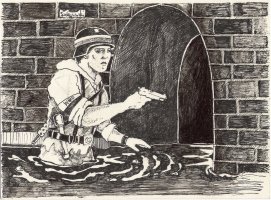
In the canal (drawing by Przemek Szelagowski)
Finally the group "Karol" reached the sewer fork, one artery leading to the Vistula, the other to the Gornoslaska. It had a guide with a good knowledge of the sewers and so could complete the route in spite of the many obstacles and dangers. And here it met the group sent out by Gen. "Monter" who demanded its return.
Repeated and twisted information confused many people in the sewers. Some retreated knocking down those wanting to advance. One of the Light Cavalry groups was pushed in the direction of the Vistula and found itself at the manhole on Wilanowska Str. On exiting they found a group of German soldiers enjoying breakfast. After exchanging gunfire, they hurriedly returned to the manhole and, after some time, managed to reach the Ujazdowskie Alley. A messenger sent by "Monter" and Lt. Col. "Karol" met them there and convinced them of the mission's unrealistic nature.
The return to Mokotow stood; the spoken word could not be retracted. The jumbled crowd, pressed in the direction of the Ujazdowskie Alley manhole. Some began shouting they should return to Mokotow and, in their excitement, trampled those who had fallen into the water. Others urged their comrades to carry on but did not know the way as they had lost their guides.
Those who exited the manhole on Wilcza Str. by the Ujazdowskie Alley were physically and mentally at the end of their tether. Some could not even see. The last group reached the manhole after blundering for 23 hours in the sewers.
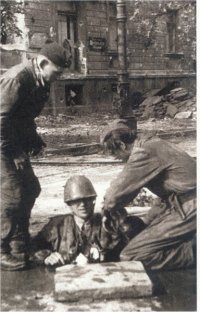
Soldier from Mokotow being received at the manhole on Ujazdowskie Alley
Gen. "Monter" categorically demanded the attempt to reach Mokotow be repeated. Lt. Col. "Karol" did not believe in the success of the venture but recommended a marching column be formed. It entered the manhole and was lead by two female liaison officers. They were accompanied by Lt. Col. "Karol" and Maj. "Tomir" from the Srodmiescie, along with his people. They were to support the defence of Mokotow.
Some time later, they met the division led by Lt. Col. "Gora," Pawel Zagorowski, Chief of Staff of "Karol". They were on the brink of exhaustion. He told them they were the last division retreating from Mokotow and it was impossible to get through.
After a short consultation, the column carrying out "Monter's" orders, moved on. There was nobody in the storm-water drain. The air deteriorated, more and more corpses appeared. Somewhere in the far distance horrific sounds and wails of unknown origin could be heard as they pervaded the air. It was the sound of demented people lost in the labyrinth of canals.
The division then came upon a stretch of canal with open manholes. Barriers awaited them at the bottom. As the soldiers approached the barriers, grenades fell from above. It was impossible to continue. Two female liaison officers with orders from "Monter" for "Zryw" decided, in spite of all, to carry on. They carefully avoided the barriers and moved on in the darkness. The squeezed through two coils of barbed wire when suddenly a pair of male hands grabbed one of them. It was an insurgent entangled in the barbed-wire and who could not hear after the grenade explosion. The shouted into his ear that he remain quiet, helped unravel him and decided to return to the Srodmiescie together. To reach Mokotow was impossible and in this situation made no sense.
Not all the Mokotow soldiers who descended the sewer reached the Srodmiescie. The panic caused by contradicting information caused many to retreat. "Monter's" ill-fated command was instrumental. Whilst wandering through the collector they lost their bearings and sense of time.
They erred for over 20 hours, looking for a way out. Being ensnared, many committed suicide individually or in groups.
On 27 September, some of the insurgents reached the open manhole on Dworkowa Str. On surfacing they were surrounded by SS men.
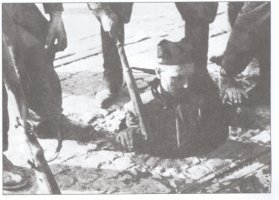
Out of the manhole on Dworkowa Str. into the hands of the SS
After checking and removing documents from around 120 defenceless insurgents and civilians, including 50 soldiers from Guard Company B-1 of the "Baszta" regiment, the military police began executing them. A German officer, who appeared in the vicinity, stopped the shooting. It must be remembered that the cease-fire was in effect and insurgents were to be treated as prisoners of war.
During the days 26-27 September 1944, a total of approx. 950 people left Mokotow by way of sewers. Due to the prevailing circumstances, many remained there forever. It was not possible to identify all the bodies that were later recovered. Many increased the number on the list "lost without trace in the Warsaw Uprising".
The events, which took place in the sewers, are indeed an essential fragment of the history of the Warsaw Uprising. The degree to which the sewers were exploited as well as the dramatic events which took place in them are unique and nowhere in the history of WWII is there anything comparable.
Every location connected to the events in the Warsaw sewers during the Uprising is documented in the In Memory Map on the Association's home page.
Many interesting details on this subject can be found in Tymoteusz Duchowski's and Juliusz Powalkiewicz's book "Sewers - Warsaw Uprising's Special Liaison Routes" published in 2003 as part of the series "Warsaw's Thermopylae 1944".
Andrzej Wajda's film "Sewer" made in 1956 and based on Jerzy Stefan Stawinski's narrative, was an epic portrayal of the events, which took place in the sewers. Stawinski was the liaison company commander of the K-4 division "Baszta" in Mokotow.
prepared by Maciej Janaszek-Seydlitz
translated by Jolanta Siestrzewitowska
Copyright © 2008 Maciej Janaszek-Seydlitz. All rights reserved.